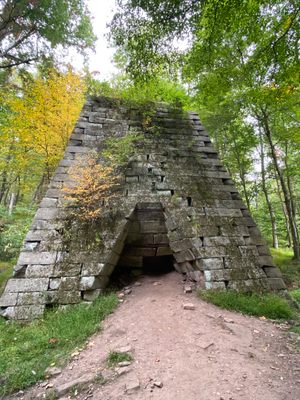About
Throughout the early 1800s, iron furnaces, also known as "bloomeries," could be found across the eastern United States, located almost anywhere there was iron ore, wood for charcoal, and water.
These furnaces processed ore into raw pig iron that was necessary to drive the industrial revolution and the growing appetite for steel and iron works that came with it. Iron furnaces were especially prevalent throughout central and western Pennsylvania and northern West Virginia (Virginia at the time). Many iron furnaces still dot the landscape in this region.
The ruins of the Henry Clay Iron Furnace, located in the woods of Coopers Rock State Forest in West Virginia, is an impressive stone structure. Built between 1834 and 1836 for the Tassie and Bissell Corporation, it could produce four tons of pig iron per day, employing over 200 people. It was the first steam-powered blast furnace in western Virginia. The furnace was formerly surrounded by a small community of dwellings with a store, church, and schoolhouse. The iron was floated down the Cheat River.
The origin of the name remains something of a mystery. Any connection to Henry Clay, the long serving statesman from Kentucky, seems uncertain. There does however appear to be a financial connection to Henry Clay Frick, a steel baron and infamous industrialist of the era (of Carnegie Steel and Johnstown Flood fame). The site is also located near the Clay Run waterway.
Related Tags
Know Before You Go
The furnace can be found approximately three-quarters of a mile hike from the Coopers Rock State Forest parking area. Access to the interior of the furnace was possible several years ago, but is not recommended today due to the risk of falling rocks and snakes in the forest.
Published
July 9, 2018







































